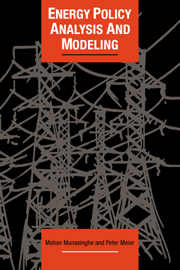Book contents
- Frontmatter
- Contents
- Preface
- List of abbreviations
- PART I Conceptual framework
- 1 Introductory ideas
- 2 Integrated national energy planning (INEP)
- 3 The role of modeling in energy policy analysis
- PART II Basic techniques
- PART III Subsectoral analysis
- PART IV Sectoral integration
- PART V Implementation
- Bibliography
- Index
2 - Integrated national energy planning (INEP)
Published online by Cambridge University Press: 05 March 2012
- Frontmatter
- Contents
- Preface
- List of abbreviations
- PART I Conceptual framework
- 1 Introductory ideas
- 2 Integrated national energy planning (INEP)
- 3 The role of modeling in energy policy analysis
- PART II Basic techniques
- PART III Subsectoral analysis
- PART IV Sectoral integration
- PART V Implementation
- Bibliography
- Index
Summary
Because of the many interactions and non-market forces that shape and affect the energy sectors of every economy, decision-makers in an increasing number of countries have realized that energy sector investment planning, pricing, and management should be carried out within an integrated national energy planning (INEP) framework which helps analyze a whole range of energy policy options over a long period of time (Munasinghe, 1980). It must however be emphasized that, while INEP provides primarily a conceptual framework for policy analysis and energy strategy formulation, policy implementation should rely mainly on market incentives and decentralized competitive forces; this point, too, is taken up in greater detail later on.
The development of the concepts and methodology of INEP and its subsequent application can be traced to the energy crisis of the 1970s. Before this period, energy was relatively cheap, and any imbalance between supply and demand was invariably dealt with by augmenting supply. The emphasis was more on the engineering and technological aspects. Furthermore, as noted previously, planning was confined to the various energy subsectors such as electricity, oil, coal, etc., with little coordination among them.
From the mid 1970s onwards, the rapidly increasing cost of all forms of energy, led by the world oil price, stimulated the development of new analytical tools and policies (Munasinghe, 1980). First, the need became apparent for greater coordination between energy supply and demand options, and for the more effective use of demand management and conservation. Second, energy-macroeconomic links began to be explored more systematically. Third, the more disaggregate analysis of both supply and demand within the energy sector offered greater opportunities for interfuel substitution (especially away from oil).
- Type
- Chapter
- Information
- Energy Policy Analysis and Modelling , pp. 12 - 19Publisher: Cambridge University PressPrint publication year: 1993
- 1
- Cited by



